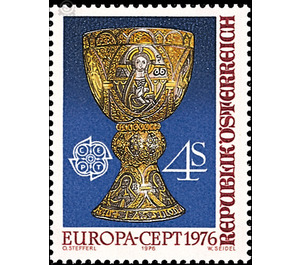CEPT - Arts and Crafts - Austria / II. Republic of Austria 1976 - 4 Shilling
Theme: Art & Culture
| Country | Austria / II. Republic of Austria |
| Issue Date | 1976 |
| Face Value | 4.00 |
| Color | multi-colored blue |
| Stamp Type | Commemorative |
| Item Type | Stamp |
| Chronological Issue Number | 859 |
| Chronological Chapter | OOS-OE2 |
| SID | 818764 |
| In 65 Wishlists | |
The Benedictine Abbey Kremsmünster in Upper Austria was founded in 777 by the Bavarian Duke Tassilo, thus committed in 1977, its 1200-year stock celebration. Over the centuries, the monastery has always been at the service of pastoral care, youth education and science. Since 1549, the fathers in a high school provide for the education of youth. The Astronomical Observatory, Kremsmünster's landmark, bears witness to the scientific activity of the Benedictines with its interesting scientific and folkloristic collections. The founder of the monastery, Duke Tassilo III. from Bavaria, came from the family of Agilolfinger. His foundations in Innichen (769) and Kremsmünster should support the proselytizing of the Danube and Alpine Slavs. Furthermore, the donor had also ordered the monasteries to clear and cultivate the surrounding land. The Kremsmünster Abbey, the Agilolfinger's most expensive legacy, has preserved a precious treasure of this period up to the present day, the so-called "Tassilo Chalice", which can also be seen as a brand motif. The precious piece was probably commissioned on the occasion of the marriage of Tassilo with the Lombard Princess Luitpurga and thus emerged in 769.


